Analysis of Management Accounting Techniques: Prime Furniture Report
VerifiedAdded on 2022/12/23
|12
|3172
|38
Report
AI Summary
This management accounting report provides a comprehensive overview of key concepts and techniques relevant to business students. The report begins with an introduction to management accounting and its essential components, including cost-accounting, inventory management, job costing, and price optimization systems. It then explores different types of management accounting reporting, such as budget reports, performance reports, and cost management reports. The report delves into cost calculation using both marginal and absorption costing techniques, including income statements and profit reconciliation statements. Furthermore, the report examines the advantages and disadvantages of various planning tools utilized in budgetary control, including zero-based budgeting, capital budgeting, and pricing strategies. Finally, the report compares how organizations respond to financial problems. The report utilizes Prime Furniture as a case study to illustrate the practical application of these concepts.
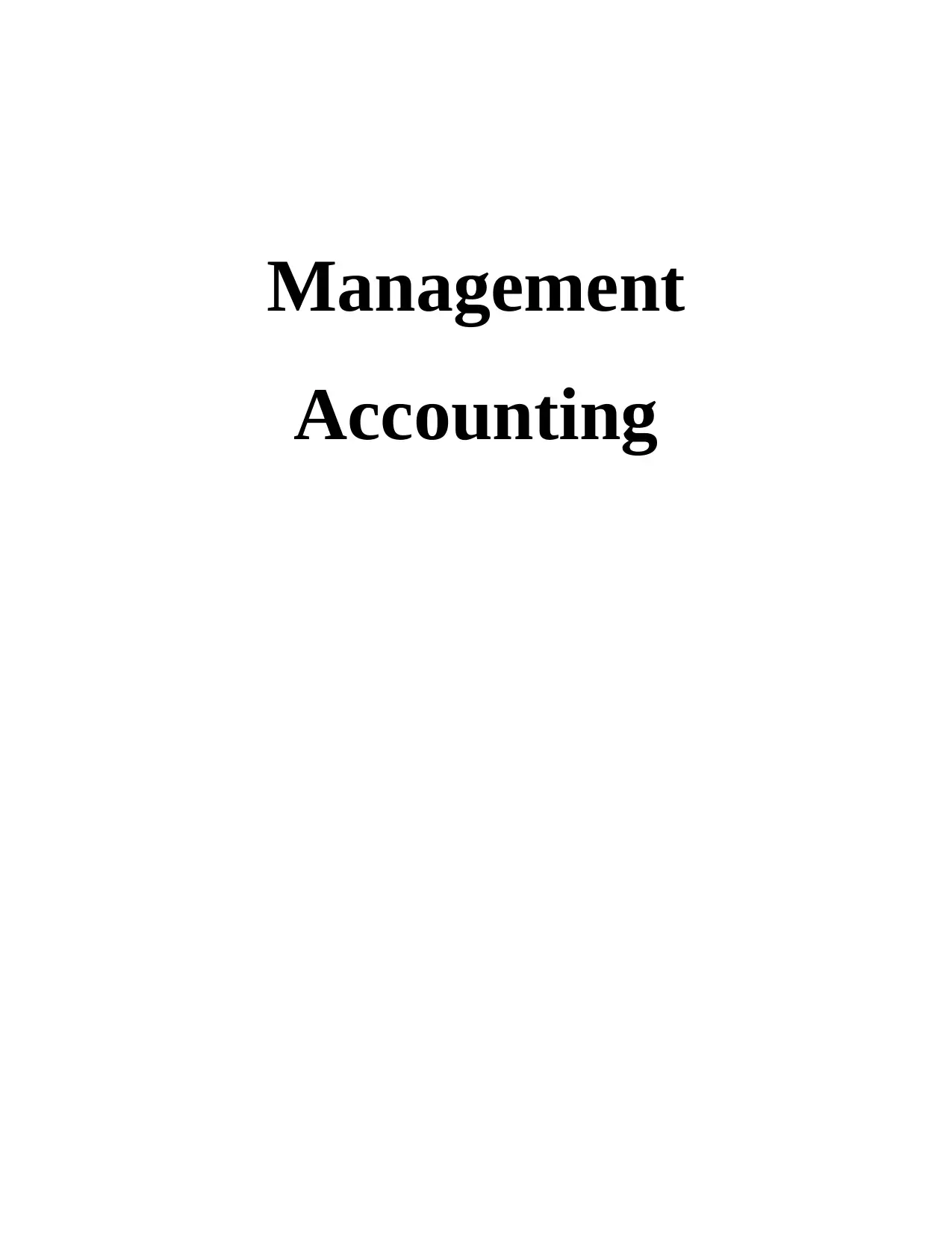
Management
Accounting
Accounting
Paraphrase This Document
Need a fresh take? Get an instant paraphrase of this document with our AI Paraphraser
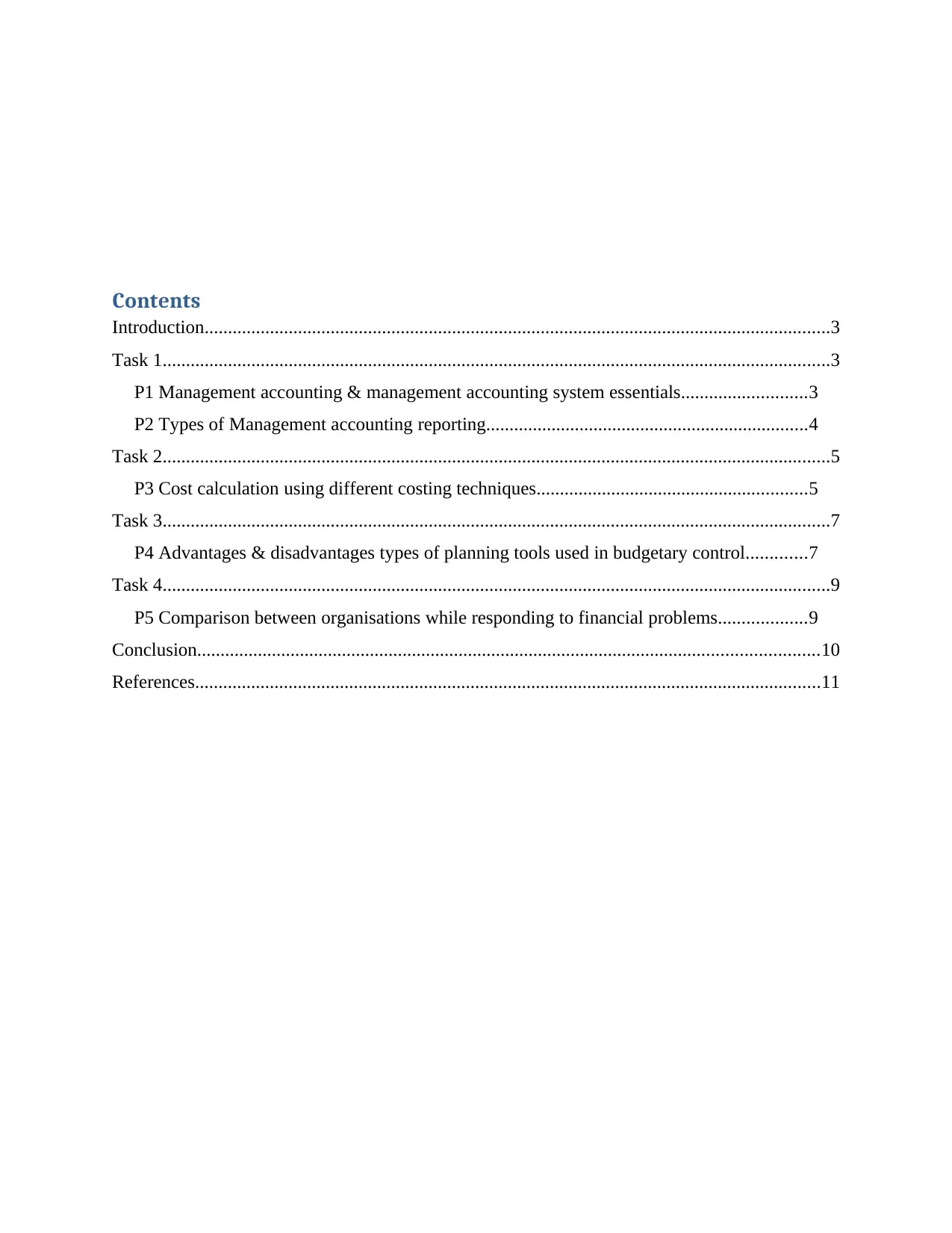
Contents
Introduction......................................................................................................................................3
Task 1...............................................................................................................................................3
P1 Management accounting & management accounting system essentials...........................3
P2 Types of Management accounting reporting.....................................................................4
Task 2...............................................................................................................................................5
P3 Cost calculation using different costing techniques..........................................................5
Task 3...............................................................................................................................................7
P4 Advantages & disadvantages types of planning tools used in budgetary control.............7
Task 4...............................................................................................................................................9
P5 Comparison between organisations while responding to financial problems...................9
Conclusion.....................................................................................................................................10
References......................................................................................................................................11
Introduction......................................................................................................................................3
Task 1...............................................................................................................................................3
P1 Management accounting & management accounting system essentials...........................3
P2 Types of Management accounting reporting.....................................................................4
Task 2...............................................................................................................................................5
P3 Cost calculation using different costing techniques..........................................................5
Task 3...............................................................................................................................................7
P4 Advantages & disadvantages types of planning tools used in budgetary control.............7
Task 4...............................................................................................................................................9
P5 Comparison between organisations while responding to financial problems...................9
Conclusion.....................................................................................................................................10
References......................................................................................................................................11
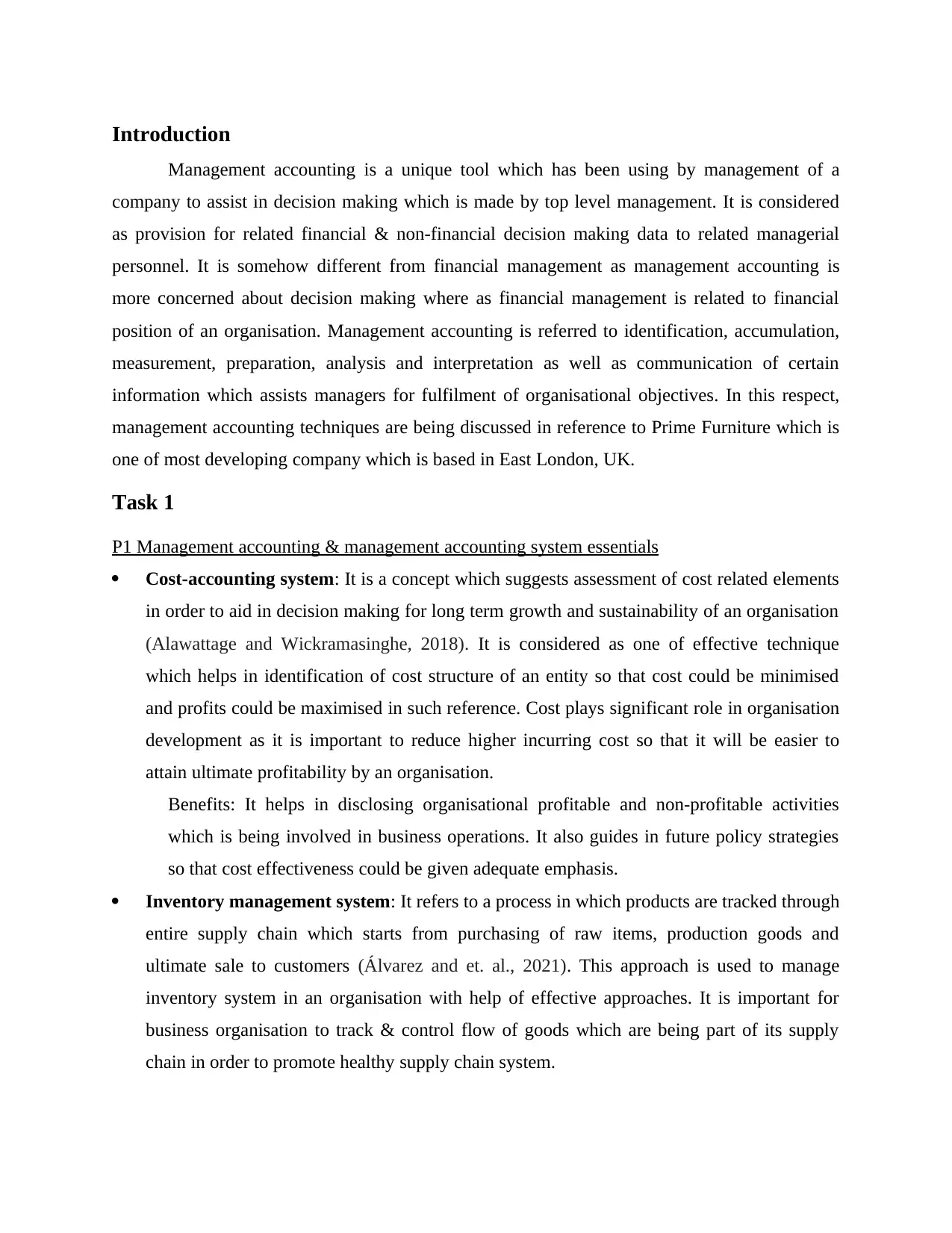
Introduction
Management accounting is a unique tool which has been using by management of a
company to assist in decision making which is made by top level management. It is considered
as provision for related financial & non-financial decision making data to related managerial
personnel. It is somehow different from financial management as management accounting is
more concerned about decision making where as financial management is related to financial
position of an organisation. Management accounting is referred to identification, accumulation,
measurement, preparation, analysis and interpretation as well as communication of certain
information which assists managers for fulfilment of organisational objectives. In this respect,
management accounting techniques are being discussed in reference to Prime Furniture which is
one of most developing company which is based in East London, UK.
Task 1
P1 Management accounting & management accounting system essentials
Cost-accounting system: It is a concept which suggests assessment of cost related elements
in order to aid in decision making for long term growth and sustainability of an organisation
(Alawattage and Wickramasinghe, 2018). It is considered as one of effective technique
which helps in identification of cost structure of an entity so that cost could be minimised
and profits could be maximised in such reference. Cost plays significant role in organisation
development as it is important to reduce higher incurring cost so that it will be easier to
attain ultimate profitability by an organisation.
Benefits: It helps in disclosing organisational profitable and non-profitable activities
which is being involved in business operations. It also guides in future policy strategies
so that cost effectiveness could be given adequate emphasis.
Inventory management system: It refers to a process in which products are tracked through
entire supply chain which starts from purchasing of raw items, production goods and
ultimate sale to customers (Álvarez and et. al., 2021). This approach is used to manage
inventory system in an organisation with help of effective approaches. It is important for
business organisation to track & control flow of goods which are being part of its supply
chain in order to promote healthy supply chain system.
Management accounting is a unique tool which has been using by management of a
company to assist in decision making which is made by top level management. It is considered
as provision for related financial & non-financial decision making data to related managerial
personnel. It is somehow different from financial management as management accounting is
more concerned about decision making where as financial management is related to financial
position of an organisation. Management accounting is referred to identification, accumulation,
measurement, preparation, analysis and interpretation as well as communication of certain
information which assists managers for fulfilment of organisational objectives. In this respect,
management accounting techniques are being discussed in reference to Prime Furniture which is
one of most developing company which is based in East London, UK.
Task 1
P1 Management accounting & management accounting system essentials
Cost-accounting system: It is a concept which suggests assessment of cost related elements
in order to aid in decision making for long term growth and sustainability of an organisation
(Alawattage and Wickramasinghe, 2018). It is considered as one of effective technique
which helps in identification of cost structure of an entity so that cost could be minimised
and profits could be maximised in such reference. Cost plays significant role in organisation
development as it is important to reduce higher incurring cost so that it will be easier to
attain ultimate profitability by an organisation.
Benefits: It helps in disclosing organisational profitable and non-profitable activities
which is being involved in business operations. It also guides in future policy strategies
so that cost effectiveness could be given adequate emphasis.
Inventory management system: It refers to a process in which products are tracked through
entire supply chain which starts from purchasing of raw items, production goods and
ultimate sale to customers (Álvarez and et. al., 2021). This approach is used to manage
inventory system in an organisation with help of effective approaches. It is important for
business organisation to track & control flow of goods which are being part of its supply
chain in order to promote healthy supply chain system.
⊘ This is a preview!⊘
Do you want full access?
Subscribe today to unlock all pages.

Trusted by 1+ million students worldwide
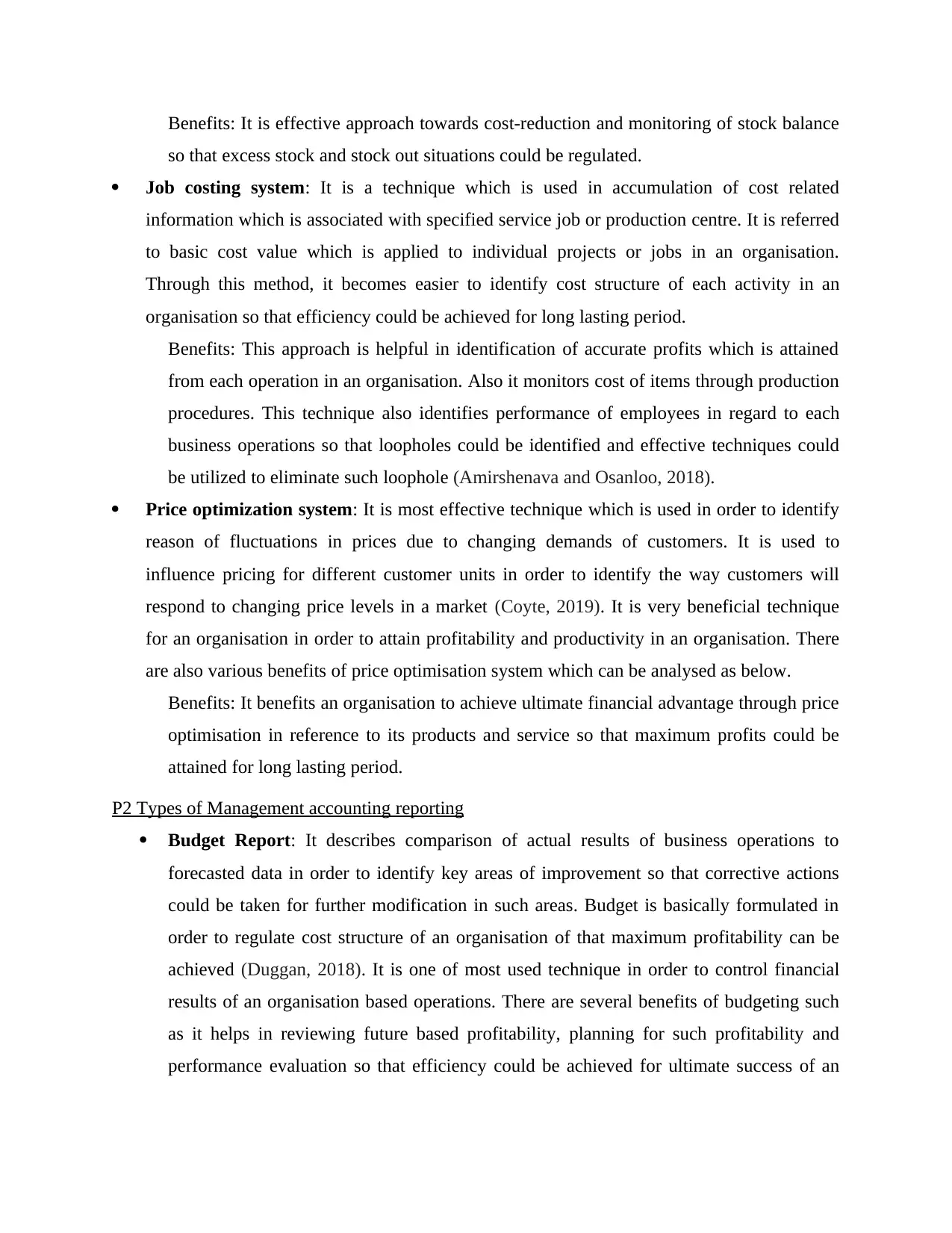
Benefits: It is effective approach towards cost-reduction and monitoring of stock balance
so that excess stock and stock out situations could be regulated.
Job costing system: It is a technique which is used in accumulation of cost related
information which is associated with specified service job or production centre. It is referred
to basic cost value which is applied to individual projects or jobs in an organisation.
Through this method, it becomes easier to identify cost structure of each activity in an
organisation so that efficiency could be achieved for long lasting period.
Benefits: This approach is helpful in identification of accurate profits which is attained
from each operation in an organisation. Also it monitors cost of items through production
procedures. This technique also identifies performance of employees in regard to each
business operations so that loopholes could be identified and effective techniques could
be utilized to eliminate such loophole (Amirshenava and Osanloo, 2018).
Price optimization system: It is most effective technique which is used in order to identify
reason of fluctuations in prices due to changing demands of customers. It is used to
influence pricing for different customer units in order to identify the way customers will
respond to changing price levels in a market (Coyte, 2019). It is very beneficial technique
for an organisation in order to attain profitability and productivity in an organisation. There
are also various benefits of price optimisation system which can be analysed as below.
Benefits: It benefits an organisation to achieve ultimate financial advantage through price
optimisation in reference to its products and service so that maximum profits could be
attained for long lasting period.
P2 Types of Management accounting reporting
Budget Report: It describes comparison of actual results of business operations to
forecasted data in order to identify key areas of improvement so that corrective actions
could be taken for further modification in such areas. Budget is basically formulated in
order to regulate cost structure of an organisation of that maximum profitability can be
achieved (Duggan, 2018). It is one of most used technique in order to control financial
results of an organisation based operations. There are several benefits of budgeting such
as it helps in reviewing future based profitability, planning for such profitability and
performance evaluation so that efficiency could be achieved for ultimate success of an
so that excess stock and stock out situations could be regulated.
Job costing system: It is a technique which is used in accumulation of cost related
information which is associated with specified service job or production centre. It is referred
to basic cost value which is applied to individual projects or jobs in an organisation.
Through this method, it becomes easier to identify cost structure of each activity in an
organisation so that efficiency could be achieved for long lasting period.
Benefits: This approach is helpful in identification of accurate profits which is attained
from each operation in an organisation. Also it monitors cost of items through production
procedures. This technique also identifies performance of employees in regard to each
business operations so that loopholes could be identified and effective techniques could
be utilized to eliminate such loophole (Amirshenava and Osanloo, 2018).
Price optimization system: It is most effective technique which is used in order to identify
reason of fluctuations in prices due to changing demands of customers. It is used to
influence pricing for different customer units in order to identify the way customers will
respond to changing price levels in a market (Coyte, 2019). It is very beneficial technique
for an organisation in order to attain profitability and productivity in an organisation. There
are also various benefits of price optimisation system which can be analysed as below.
Benefits: It benefits an organisation to achieve ultimate financial advantage through price
optimisation in reference to its products and service so that maximum profits could be
attained for long lasting period.
P2 Types of Management accounting reporting
Budget Report: It describes comparison of actual results of business operations to
forecasted data in order to identify key areas of improvement so that corrective actions
could be taken for further modification in such areas. Budget is basically formulated in
order to regulate cost structure of an organisation of that maximum profitability can be
achieved (Duggan, 2018). It is one of most used technique in order to control financial
results of an organisation based operations. There are several benefits of budgeting such
as it helps in reviewing future based profitability, planning for such profitability and
performance evaluation so that efficiency could be achieved for ultimate success of an
Paraphrase This Document
Need a fresh take? Get an instant paraphrase of this document with our AI Paraphraser
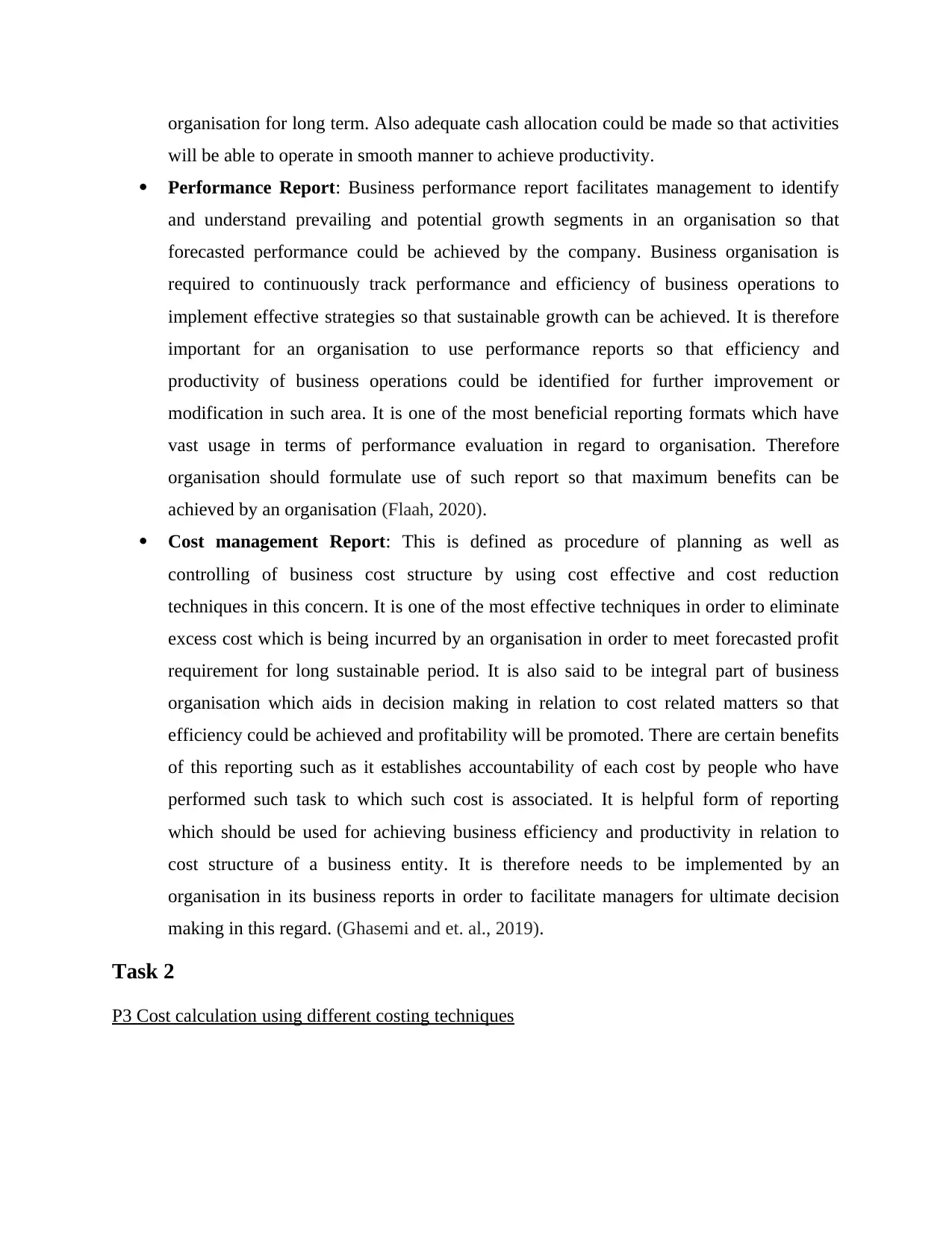
organisation for long term. Also adequate cash allocation could be made so that activities
will be able to operate in smooth manner to achieve productivity.
Performance Report: Business performance report facilitates management to identify
and understand prevailing and potential growth segments in an organisation so that
forecasted performance could be achieved by the company. Business organisation is
required to continuously track performance and efficiency of business operations to
implement effective strategies so that sustainable growth can be achieved. It is therefore
important for an organisation to use performance reports so that efficiency and
productivity of business operations could be identified for further improvement or
modification in such area. It is one of the most beneficial reporting formats which have
vast usage in terms of performance evaluation in regard to organisation. Therefore
organisation should formulate use of such report so that maximum benefits can be
achieved by an organisation (Flaah, 2020).
Cost management Report: This is defined as procedure of planning as well as
controlling of business cost structure by using cost effective and cost reduction
techniques in this concern. It is one of the most effective techniques in order to eliminate
excess cost which is being incurred by an organisation in order to meet forecasted profit
requirement for long sustainable period. It is also said to be integral part of business
organisation which aids in decision making in relation to cost related matters so that
efficiency could be achieved and profitability will be promoted. There are certain benefits
of this reporting such as it establishes accountability of each cost by people who have
performed such task to which such cost is associated. It is helpful form of reporting
which should be used for achieving business efficiency and productivity in relation to
cost structure of a business entity. It is therefore needs to be implemented by an
organisation in its business reports in order to facilitate managers for ultimate decision
making in this regard. (Ghasemi and et. al., 2019).
Task 2
P3 Cost calculation using different costing techniques
will be able to operate in smooth manner to achieve productivity.
Performance Report: Business performance report facilitates management to identify
and understand prevailing and potential growth segments in an organisation so that
forecasted performance could be achieved by the company. Business organisation is
required to continuously track performance and efficiency of business operations to
implement effective strategies so that sustainable growth can be achieved. It is therefore
important for an organisation to use performance reports so that efficiency and
productivity of business operations could be identified for further improvement or
modification in such area. It is one of the most beneficial reporting formats which have
vast usage in terms of performance evaluation in regard to organisation. Therefore
organisation should formulate use of such report so that maximum benefits can be
achieved by an organisation (Flaah, 2020).
Cost management Report: This is defined as procedure of planning as well as
controlling of business cost structure by using cost effective and cost reduction
techniques in this concern. It is one of the most effective techniques in order to eliminate
excess cost which is being incurred by an organisation in order to meet forecasted profit
requirement for long sustainable period. It is also said to be integral part of business
organisation which aids in decision making in relation to cost related matters so that
efficiency could be achieved and profitability will be promoted. There are certain benefits
of this reporting such as it establishes accountability of each cost by people who have
performed such task to which such cost is associated. It is helpful form of reporting
which should be used for achieving business efficiency and productivity in relation to
cost structure of a business entity. It is therefore needs to be implemented by an
organisation in its business reports in order to facilitate managers for ultimate decision
making in this regard. (Ghasemi and et. al., 2019).
Task 2
P3 Cost calculation using different costing techniques
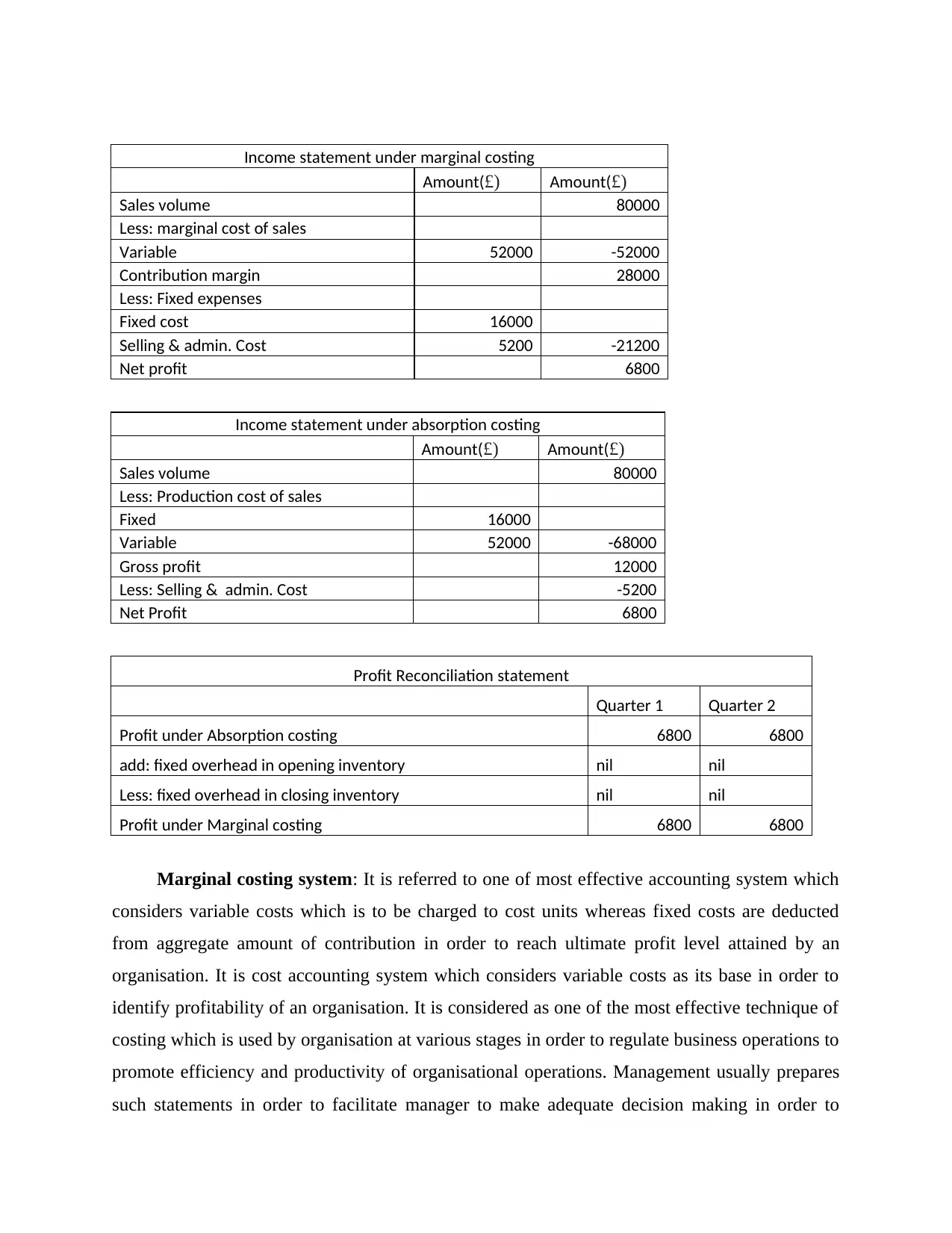
Income statement under marginal costing
Amount(£) Amount(£)
Sales volume 80000
Less: marginal cost of sales
Variable 52000 -52000
Contribution margin 28000
Less: Fixed expenses
Fixed cost 16000
Selling & admin. Cost 5200 -21200
Net profit 6800
Income statement under absorption costing
Amount(£) Amount(£)
Sales volume 80000
Less: Production cost of sales
Fixed 16000
Variable 52000 -68000
Gross profit 12000
Less: Selling & admin. Cost -5200
Net Profit 6800
Profit Reconciliation statement
Quarter 1 Quarter 2
Profit under Absorption costing 6800 6800
add: fixed overhead in opening inventory nil nil
Less: fixed overhead in closing inventory nil nil
Profit under Marginal costing 6800 6800
Marginal costing system: It is referred to one of most effective accounting system which
considers variable costs which is to be charged to cost units whereas fixed costs are deducted
from aggregate amount of contribution in order to reach ultimate profit level attained by an
organisation. It is cost accounting system which considers variable costs as its base in order to
identify profitability of an organisation. It is considered as one of the most effective technique of
costing which is used by organisation at various stages in order to regulate business operations to
promote efficiency and productivity of organisational operations. Management usually prepares
such statements in order to facilitate manager to make adequate decision making in order to
Amount(£) Amount(£)
Sales volume 80000
Less: marginal cost of sales
Variable 52000 -52000
Contribution margin 28000
Less: Fixed expenses
Fixed cost 16000
Selling & admin. Cost 5200 -21200
Net profit 6800
Income statement under absorption costing
Amount(£) Amount(£)
Sales volume 80000
Less: Production cost of sales
Fixed 16000
Variable 52000 -68000
Gross profit 12000
Less: Selling & admin. Cost -5200
Net Profit 6800
Profit Reconciliation statement
Quarter 1 Quarter 2
Profit under Absorption costing 6800 6800
add: fixed overhead in opening inventory nil nil
Less: fixed overhead in closing inventory nil nil
Profit under Marginal costing 6800 6800
Marginal costing system: It is referred to one of most effective accounting system which
considers variable costs which is to be charged to cost units whereas fixed costs are deducted
from aggregate amount of contribution in order to reach ultimate profit level attained by an
organisation. It is cost accounting system which considers variable costs as its base in order to
identify profitability of an organisation. It is considered as one of the most effective technique of
costing which is used by organisation at various stages in order to regulate business operations to
promote efficiency and productivity of organisational operations. Management usually prepares
such statements in order to facilitate manager to make adequate decision making in order to
⊘ This is a preview!⊘
Do you want full access?
Subscribe today to unlock all pages.

Trusted by 1+ million students worldwide
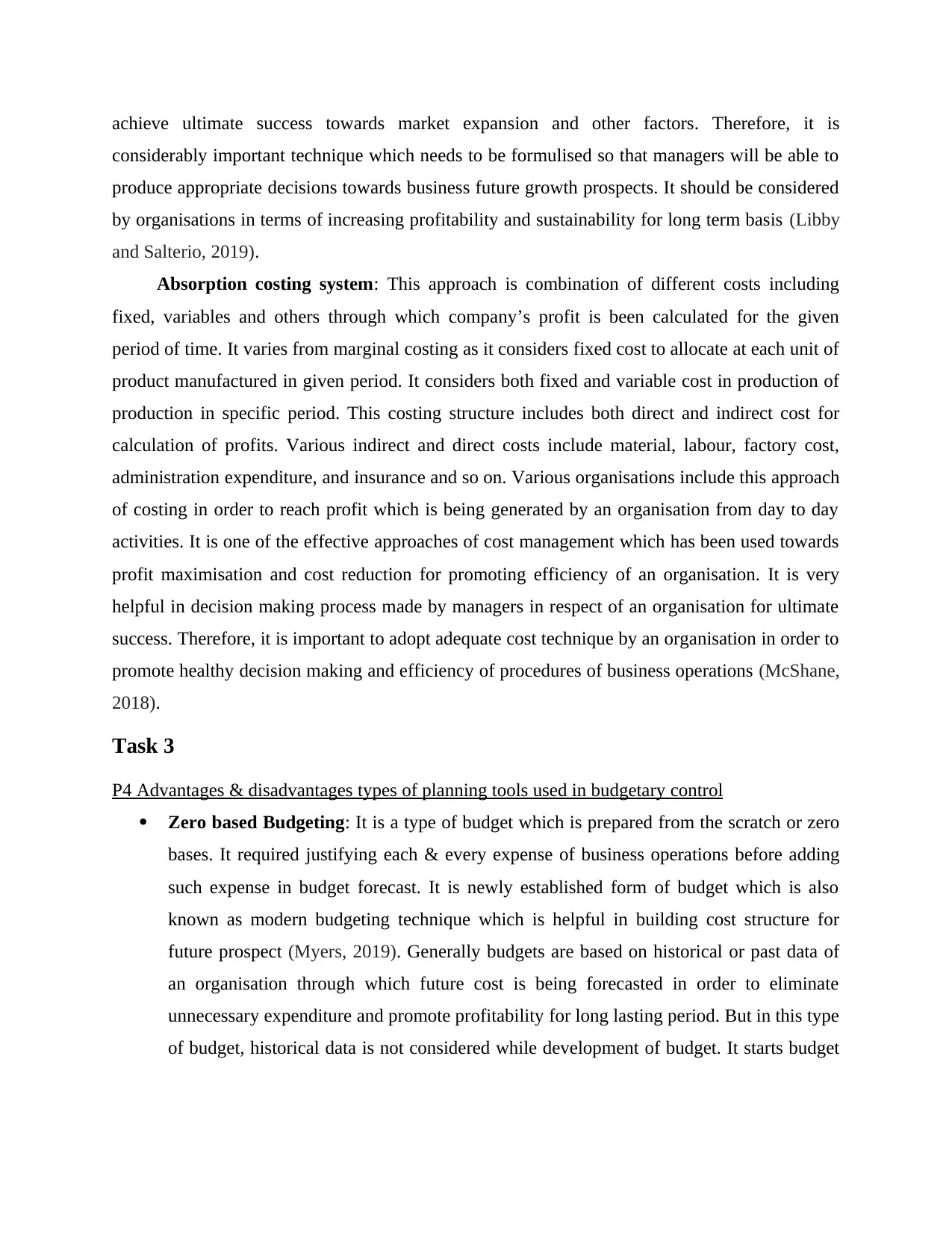
achieve ultimate success towards market expansion and other factors. Therefore, it is
considerably important technique which needs to be formulised so that managers will be able to
produce appropriate decisions towards business future growth prospects. It should be considered
by organisations in terms of increasing profitability and sustainability for long term basis (Libby
and Salterio, 2019).
Absorption costing system: This approach is combination of different costs including
fixed, variables and others through which company’s profit is been calculated for the given
period of time. It varies from marginal costing as it considers fixed cost to allocate at each unit of
product manufactured in given period. It considers both fixed and variable cost in production of
production in specific period. This costing structure includes both direct and indirect cost for
calculation of profits. Various indirect and direct costs include material, labour, factory cost,
administration expenditure, and insurance and so on. Various organisations include this approach
of costing in order to reach profit which is being generated by an organisation from day to day
activities. It is one of the effective approaches of cost management which has been used towards
profit maximisation and cost reduction for promoting efficiency of an organisation. It is very
helpful in decision making process made by managers in respect of an organisation for ultimate
success. Therefore, it is important to adopt adequate cost technique by an organisation in order to
promote healthy decision making and efficiency of procedures of business operations (McShane,
2018).
Task 3
P4 Advantages & disadvantages types of planning tools used in budgetary control
Zero based Budgeting: It is a type of budget which is prepared from the scratch or zero
bases. It required justifying each & every expense of business operations before adding
such expense in budget forecast. It is newly established form of budget which is also
known as modern budgeting technique which is helpful in building cost structure for
future prospect (Myers, 2019). Generally budgets are based on historical or past data of
an organisation through which future cost is being forecasted in order to eliminate
unnecessary expenditure and promote profitability for long lasting period. But in this type
of budget, historical data is not considered while development of budget. It starts budget
considerably important technique which needs to be formulised so that managers will be able to
produce appropriate decisions towards business future growth prospects. It should be considered
by organisations in terms of increasing profitability and sustainability for long term basis (Libby
and Salterio, 2019).
Absorption costing system: This approach is combination of different costs including
fixed, variables and others through which company’s profit is been calculated for the given
period of time. It varies from marginal costing as it considers fixed cost to allocate at each unit of
product manufactured in given period. It considers both fixed and variable cost in production of
production in specific period. This costing structure includes both direct and indirect cost for
calculation of profits. Various indirect and direct costs include material, labour, factory cost,
administration expenditure, and insurance and so on. Various organisations include this approach
of costing in order to reach profit which is being generated by an organisation from day to day
activities. It is one of the effective approaches of cost management which has been used towards
profit maximisation and cost reduction for promoting efficiency of an organisation. It is very
helpful in decision making process made by managers in respect of an organisation for ultimate
success. Therefore, it is important to adopt adequate cost technique by an organisation in order to
promote healthy decision making and efficiency of procedures of business operations (McShane,
2018).
Task 3
P4 Advantages & disadvantages types of planning tools used in budgetary control
Zero based Budgeting: It is a type of budget which is prepared from the scratch or zero
bases. It required justifying each & every expense of business operations before adding
such expense in budget forecast. It is newly established form of budget which is also
known as modern budgeting technique which is helpful in building cost structure for
future prospect (Myers, 2019). Generally budgets are based on historical or past data of
an organisation through which future cost is being forecasted in order to eliminate
unnecessary expenditure and promote profitability for long lasting period. But in this type
of budget, historical data is not considered while development of budget. It starts budget
Paraphrase This Document
Need a fresh take? Get an instant paraphrase of this document with our AI Paraphraser
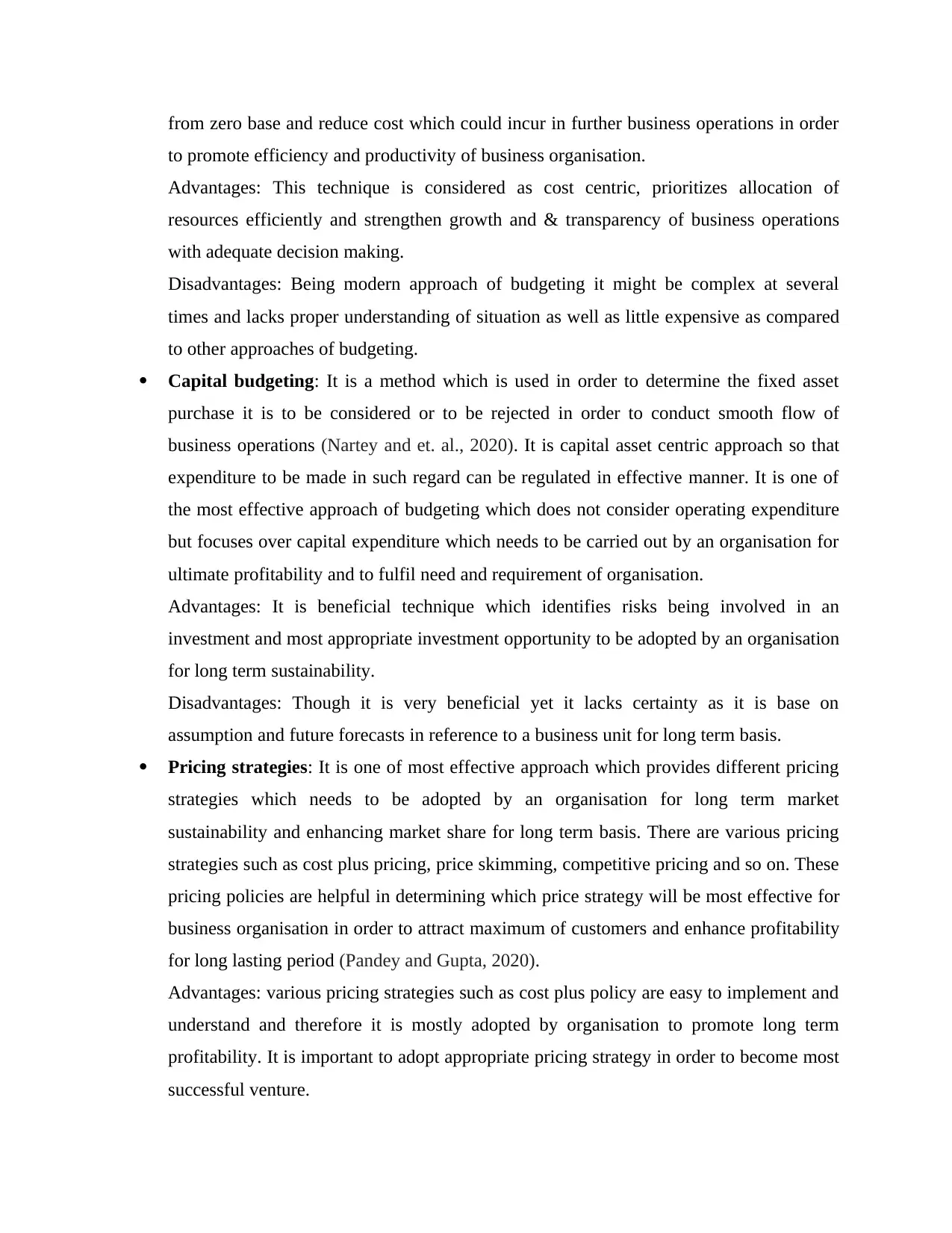
from zero base and reduce cost which could incur in further business operations in order
to promote efficiency and productivity of business organisation.
Advantages: This technique is considered as cost centric, prioritizes allocation of
resources efficiently and strengthen growth and & transparency of business operations
with adequate decision making.
Disadvantages: Being modern approach of budgeting it might be complex at several
times and lacks proper understanding of situation as well as little expensive as compared
to other approaches of budgeting.
Capital budgeting: It is a method which is used in order to determine the fixed asset
purchase it is to be considered or to be rejected in order to conduct smooth flow of
business operations (Nartey and et. al., 2020). It is capital asset centric approach so that
expenditure to be made in such regard can be regulated in effective manner. It is one of
the most effective approach of budgeting which does not consider operating expenditure
but focuses over capital expenditure which needs to be carried out by an organisation for
ultimate profitability and to fulfil need and requirement of organisation.
Advantages: It is beneficial technique which identifies risks being involved in an
investment and most appropriate investment opportunity to be adopted by an organisation
for long term sustainability.
Disadvantages: Though it is very beneficial yet it lacks certainty as it is base on
assumption and future forecasts in reference to a business unit for long term basis.
Pricing strategies: It is one of most effective approach which provides different pricing
strategies which needs to be adopted by an organisation for long term market
sustainability and enhancing market share for long term basis. There are various pricing
strategies such as cost plus pricing, price skimming, competitive pricing and so on. These
pricing policies are helpful in determining which price strategy will be most effective for
business organisation in order to attract maximum of customers and enhance profitability
for long lasting period (Pandey and Gupta, 2020).
Advantages: various pricing strategies such as cost plus policy are easy to implement and
understand and therefore it is mostly adopted by organisation to promote long term
profitability. It is important to adopt appropriate pricing strategy in order to become most
successful venture.
to promote efficiency and productivity of business organisation.
Advantages: This technique is considered as cost centric, prioritizes allocation of
resources efficiently and strengthen growth and & transparency of business operations
with adequate decision making.
Disadvantages: Being modern approach of budgeting it might be complex at several
times and lacks proper understanding of situation as well as little expensive as compared
to other approaches of budgeting.
Capital budgeting: It is a method which is used in order to determine the fixed asset
purchase it is to be considered or to be rejected in order to conduct smooth flow of
business operations (Nartey and et. al., 2020). It is capital asset centric approach so that
expenditure to be made in such regard can be regulated in effective manner. It is one of
the most effective approach of budgeting which does not consider operating expenditure
but focuses over capital expenditure which needs to be carried out by an organisation for
ultimate profitability and to fulfil need and requirement of organisation.
Advantages: It is beneficial technique which identifies risks being involved in an
investment and most appropriate investment opportunity to be adopted by an organisation
for long term sustainability.
Disadvantages: Though it is very beneficial yet it lacks certainty as it is base on
assumption and future forecasts in reference to a business unit for long term basis.
Pricing strategies: It is one of most effective approach which provides different pricing
strategies which needs to be adopted by an organisation for long term market
sustainability and enhancing market share for long term basis. There are various pricing
strategies such as cost plus pricing, price skimming, competitive pricing and so on. These
pricing policies are helpful in determining which price strategy will be most effective for
business organisation in order to attract maximum of customers and enhance profitability
for long lasting period (Pandey and Gupta, 2020).
Advantages: various pricing strategies such as cost plus policy are easy to implement and
understand and therefore it is mostly adopted by organisation to promote long term
profitability. It is important to adopt appropriate pricing strategy in order to become most
successful venture.
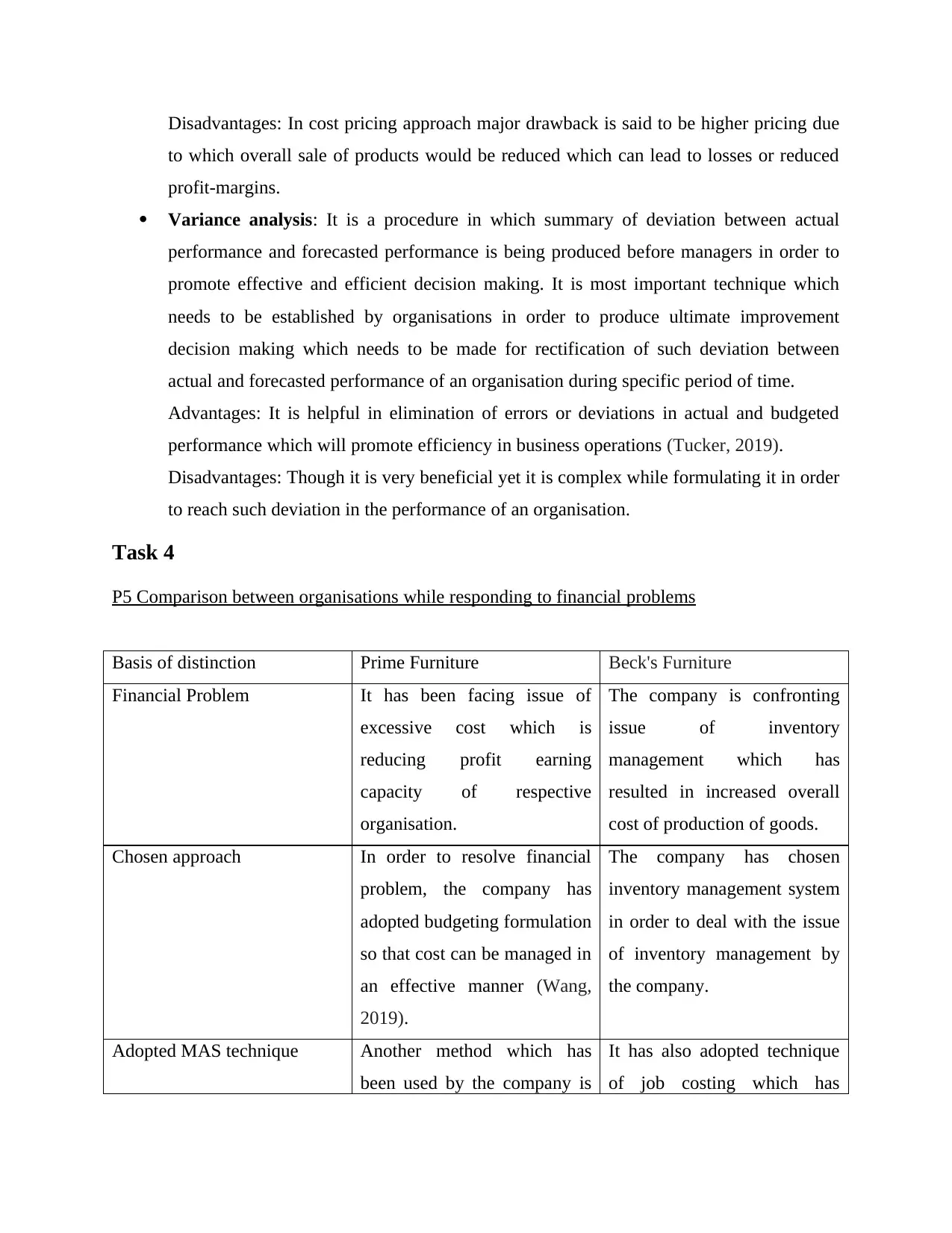
Disadvantages: In cost pricing approach major drawback is said to be higher pricing due
to which overall sale of products would be reduced which can lead to losses or reduced
profit-margins.
Variance analysis: It is a procedure in which summary of deviation between actual
performance and forecasted performance is being produced before managers in order to
promote effective and efficient decision making. It is most important technique which
needs to be established by organisations in order to produce ultimate improvement
decision making which needs to be made for rectification of such deviation between
actual and forecasted performance of an organisation during specific period of time.
Advantages: It is helpful in elimination of errors or deviations in actual and budgeted
performance which will promote efficiency in business operations (Tucker, 2019).
Disadvantages: Though it is very beneficial yet it is complex while formulating it in order
to reach such deviation in the performance of an organisation.
Task 4
P5 Comparison between organisations while responding to financial problems
Basis of distinction Prime Furniture Beck's Furniture
Financial Problem It has been facing issue of
excessive cost which is
reducing profit earning
capacity of respective
organisation.
The company is confronting
issue of inventory
management which has
resulted in increased overall
cost of production of goods.
Chosen approach In order to resolve financial
problem, the company has
adopted budgeting formulation
so that cost can be managed in
an effective manner (Wang,
2019).
The company has chosen
inventory management system
in order to deal with the issue
of inventory management by
the company.
Adopted MAS technique Another method which has
been used by the company is
It has also adopted technique
of job costing which has
to which overall sale of products would be reduced which can lead to losses or reduced
profit-margins.
Variance analysis: It is a procedure in which summary of deviation between actual
performance and forecasted performance is being produced before managers in order to
promote effective and efficient decision making. It is most important technique which
needs to be established by organisations in order to produce ultimate improvement
decision making which needs to be made for rectification of such deviation between
actual and forecasted performance of an organisation during specific period of time.
Advantages: It is helpful in elimination of errors or deviations in actual and budgeted
performance which will promote efficiency in business operations (Tucker, 2019).
Disadvantages: Though it is very beneficial yet it is complex while formulating it in order
to reach such deviation in the performance of an organisation.
Task 4
P5 Comparison between organisations while responding to financial problems
Basis of distinction Prime Furniture Beck's Furniture
Financial Problem It has been facing issue of
excessive cost which is
reducing profit earning
capacity of respective
organisation.
The company is confronting
issue of inventory
management which has
resulted in increased overall
cost of production of goods.
Chosen approach In order to resolve financial
problem, the company has
adopted budgeting formulation
so that cost can be managed in
an effective manner (Wang,
2019).
The company has chosen
inventory management system
in order to deal with the issue
of inventory management by
the company.
Adopted MAS technique Another method which has
been used by the company is
It has also adopted technique
of job costing which has
⊘ This is a preview!⊘
Do you want full access?
Subscribe today to unlock all pages.

Trusted by 1+ million students worldwide
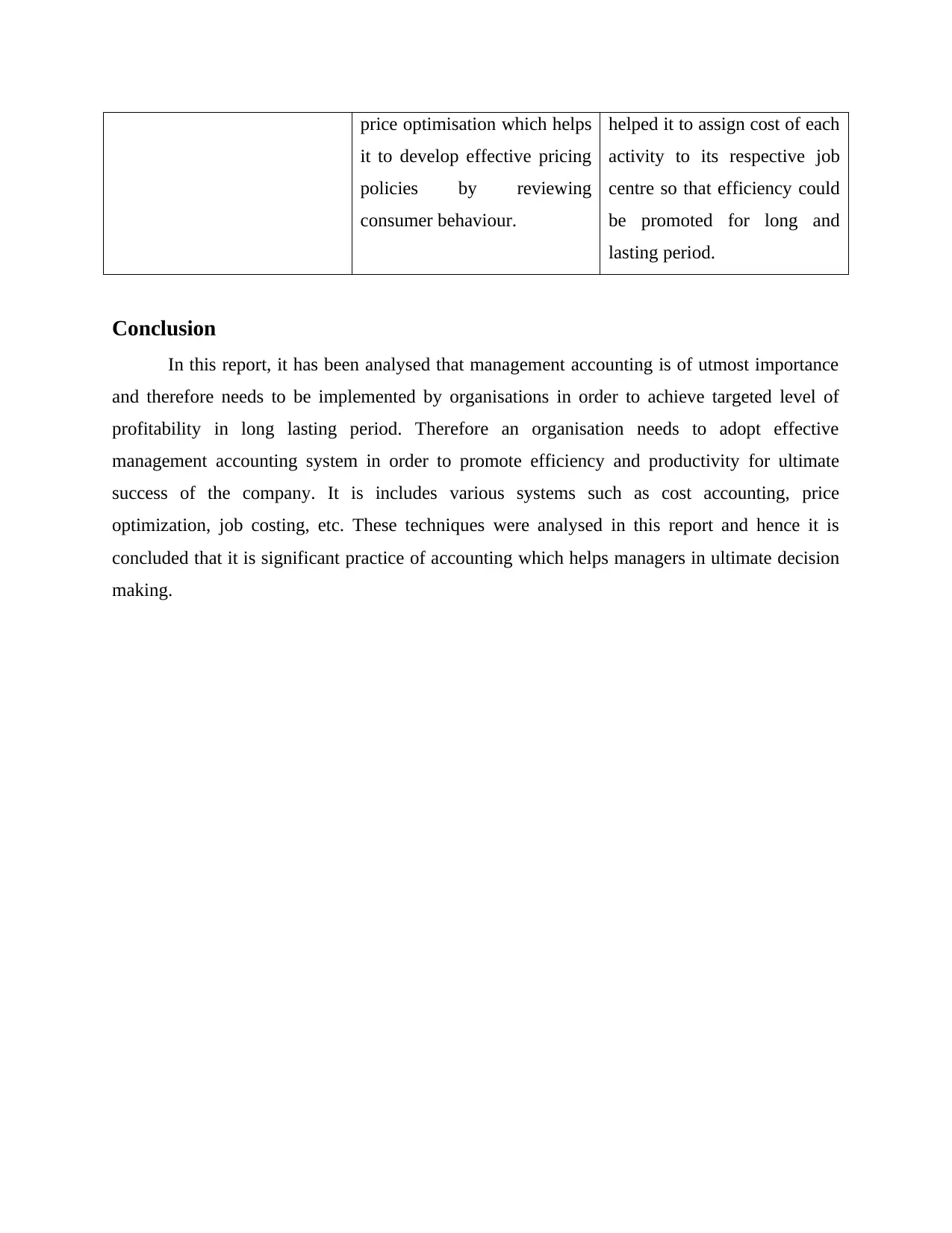
price optimisation which helps
it to develop effective pricing
policies by reviewing
consumer behaviour.
helped it to assign cost of each
activity to its respective job
centre so that efficiency could
be promoted for long and
lasting period.
Conclusion
In this report, it has been analysed that management accounting is of utmost importance
and therefore needs to be implemented by organisations in order to achieve targeted level of
profitability in long lasting period. Therefore an organisation needs to adopt effective
management accounting system in order to promote efficiency and productivity for ultimate
success of the company. It is includes various systems such as cost accounting, price
optimization, job costing, etc. These techniques were analysed in this report and hence it is
concluded that it is significant practice of accounting which helps managers in ultimate decision
making.
it to develop effective pricing
policies by reviewing
consumer behaviour.
helped it to assign cost of each
activity to its respective job
centre so that efficiency could
be promoted for long and
lasting period.
Conclusion
In this report, it has been analysed that management accounting is of utmost importance
and therefore needs to be implemented by organisations in order to achieve targeted level of
profitability in long lasting period. Therefore an organisation needs to adopt effective
management accounting system in order to promote efficiency and productivity for ultimate
success of the company. It is includes various systems such as cost accounting, price
optimization, job costing, etc. These techniques were analysed in this report and hence it is
concluded that it is significant practice of accounting which helps managers in ultimate decision
making.
Paraphrase This Document
Need a fresh take? Get an instant paraphrase of this document with our AI Paraphraser
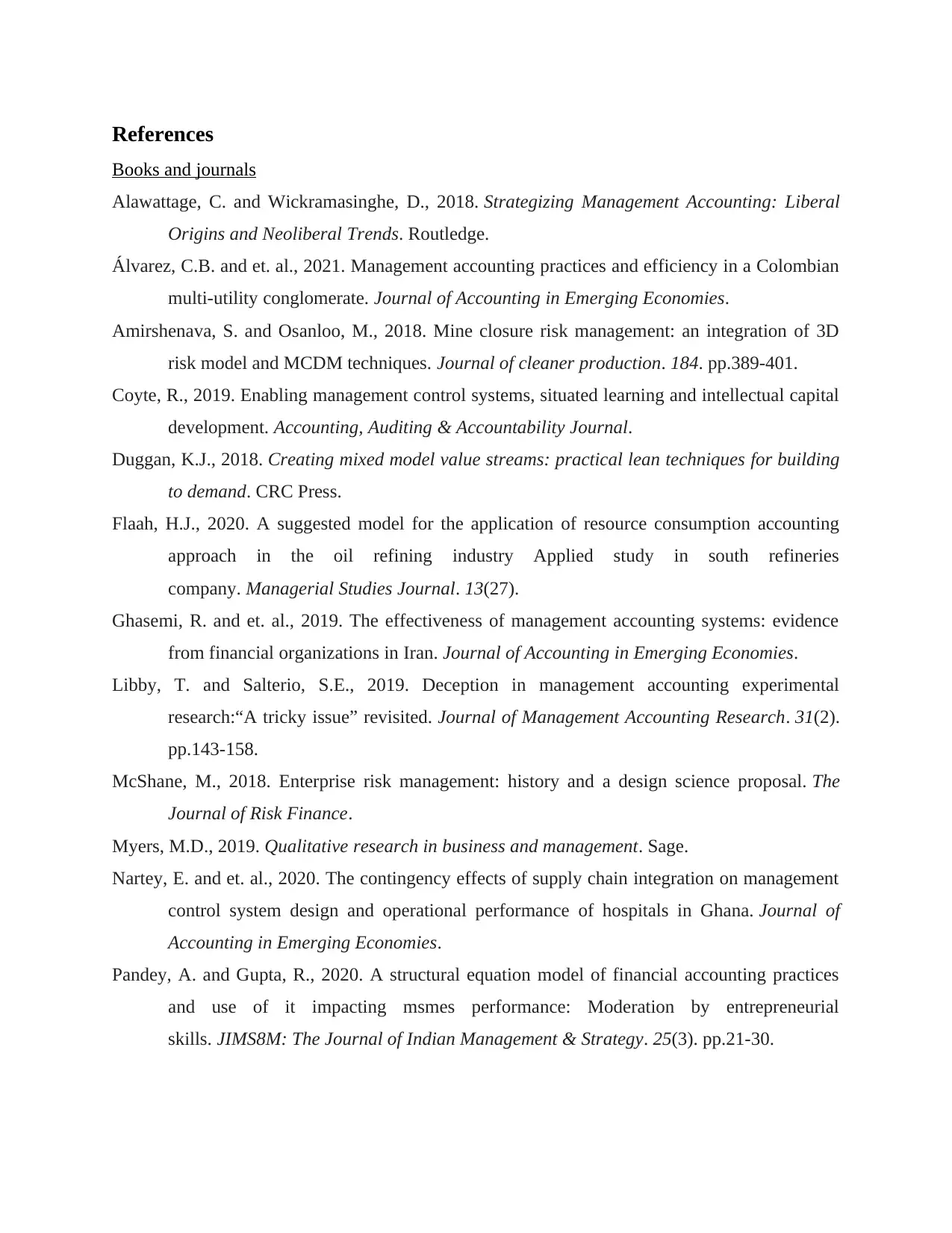
References
Books and journals
Alawattage, C. and Wickramasinghe, D., 2018. Strategizing Management Accounting: Liberal
Origins and Neoliberal Trends. Routledge.
Álvarez, C.B. and et. al., 2021. Management accounting practices and efficiency in a Colombian
multi-utility conglomerate. Journal of Accounting in Emerging Economies.
Amirshenava, S. and Osanloo, M., 2018. Mine closure risk management: an integration of 3D
risk model and MCDM techniques. Journal of cleaner production. 184. pp.389-401.
Coyte, R., 2019. Enabling management control systems, situated learning and intellectual capital
development. Accounting, Auditing & Accountability Journal.
Duggan, K.J., 2018. Creating mixed model value streams: practical lean techniques for building
to demand. CRC Press.
Flaah, H.J., 2020. A suggested model for the application of resource consumption accounting
approach in the oil refining industry Applied study in south refineries
company. Managerial Studies Journal. 13(27).
Ghasemi, R. and et. al., 2019. The effectiveness of management accounting systems: evidence
from financial organizations in Iran. Journal of Accounting in Emerging Economies.
Libby, T. and Salterio, S.E., 2019. Deception in management accounting experimental
research:“A tricky issue” revisited. Journal of Management Accounting Research. 31(2).
pp.143-158.
McShane, M., 2018. Enterprise risk management: history and a design science proposal. The
Journal of Risk Finance.
Myers, M.D., 2019. Qualitative research in business and management. Sage.
Nartey, E. and et. al., 2020. The contingency effects of supply chain integration on management
control system design and operational performance of hospitals in Ghana. Journal of
Accounting in Emerging Economies.
Pandey, A. and Gupta, R., 2020. A structural equation model of financial accounting practices
and use of it impacting msmes performance: Moderation by entrepreneurial
skills. JIMS8M: The Journal of Indian Management & Strategy. 25(3). pp.21-30.
Books and journals
Alawattage, C. and Wickramasinghe, D., 2018. Strategizing Management Accounting: Liberal
Origins and Neoliberal Trends. Routledge.
Álvarez, C.B. and et. al., 2021. Management accounting practices and efficiency in a Colombian
multi-utility conglomerate. Journal of Accounting in Emerging Economies.
Amirshenava, S. and Osanloo, M., 2018. Mine closure risk management: an integration of 3D
risk model and MCDM techniques. Journal of cleaner production. 184. pp.389-401.
Coyte, R., 2019. Enabling management control systems, situated learning and intellectual capital
development. Accounting, Auditing & Accountability Journal.
Duggan, K.J., 2018. Creating mixed model value streams: practical lean techniques for building
to demand. CRC Press.
Flaah, H.J., 2020. A suggested model for the application of resource consumption accounting
approach in the oil refining industry Applied study in south refineries
company. Managerial Studies Journal. 13(27).
Ghasemi, R. and et. al., 2019. The effectiveness of management accounting systems: evidence
from financial organizations in Iran. Journal of Accounting in Emerging Economies.
Libby, T. and Salterio, S.E., 2019. Deception in management accounting experimental
research:“A tricky issue” revisited. Journal of Management Accounting Research. 31(2).
pp.143-158.
McShane, M., 2018. Enterprise risk management: history and a design science proposal. The
Journal of Risk Finance.
Myers, M.D., 2019. Qualitative research in business and management. Sage.
Nartey, E. and et. al., 2020. The contingency effects of supply chain integration on management
control system design and operational performance of hospitals in Ghana. Journal of
Accounting in Emerging Economies.
Pandey, A. and Gupta, R., 2020. A structural equation model of financial accounting practices
and use of it impacting msmes performance: Moderation by entrepreneurial
skills. JIMS8M: The Journal of Indian Management & Strategy. 25(3). pp.21-30.
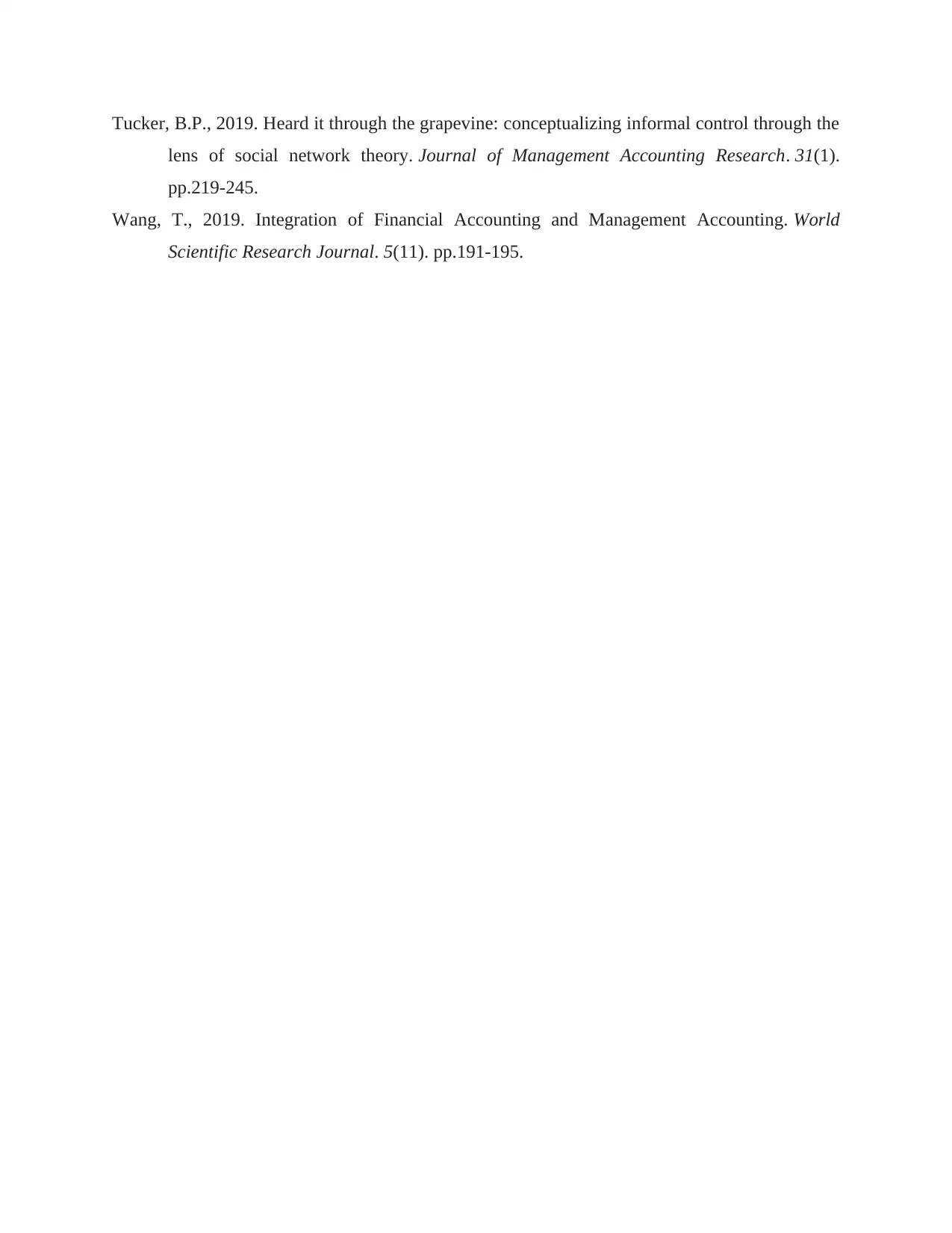
Tucker, B.P., 2019. Heard it through the grapevine: conceptualizing informal control through the
lens of social network theory. Journal of Management Accounting Research. 31(1).
pp.219-245.
Wang, T., 2019. Integration of Financial Accounting and Management Accounting. World
Scientific Research Journal. 5(11). pp.191-195.
lens of social network theory. Journal of Management Accounting Research. 31(1).
pp.219-245.
Wang, T., 2019. Integration of Financial Accounting and Management Accounting. World
Scientific Research Journal. 5(11). pp.191-195.
⊘ This is a preview!⊘
Do you want full access?
Subscribe today to unlock all pages.

Trusted by 1+ million students worldwide
1 out of 12
Related Documents
Your All-in-One AI-Powered Toolkit for Academic Success.
+13062052269
info@desklib.com
Available 24*7 on WhatsApp / Email
![[object Object]](/_next/static/media/star-bottom.7253800d.svg)
Unlock your academic potential
Copyright © 2020–2025 A2Z Services. All Rights Reserved. Developed and managed by ZUCOL.




